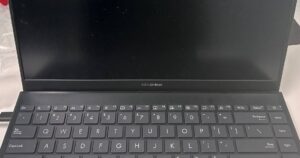What is An iMac?
iMac is an all in one computer that comes from the Macintosh line of computers designed by Apple.
Generally seen as desktop computers, they do differ from the Mac Pro in that they do not have a tower or an actual desktop component. In its stead, everything the computer needs to run is located right behind the screen, thus the popular moniker of all in one.
In the modern era, iMacs has become one of the most popular types of Mac computers within the consumer market, with its ability to work fast and good specification built proving to be popular among the many professionals. Wile most of the newest models of these computers are designed to be sleek, this has not always been the case.
Expandability or the Lack Thereof
Something commonly known about this version of the Macintosh line is its design limits the types of expansion that end users can perform, which may sound like a bad feature, yet not necessarily should be the case. This design decision allowed Apple to create a well-built, aesthetically compact machine that has all the features many individuals will find necessary for your daily use.
Created for individuals who spends most of their time working on the software portion of the computer, investing little to no time on the hardware. This is an important selling point of an iMac, particularly if you enjoy fiddling with hardware more than you realize. But if you just want to get the work done (and have a little fun), the iMac can deliver.
Expandable RAM
The iMac may not be known to be particularly flexible when it comes to user-configurable hardware, as depending on the model, the iMac can have no user-accessible RAM slots, two user-accessible RAM slots, or four user-accessible RAM slots.
For the case of the latter two, it would require complete disassembly of the iMac to change RAM, a task not many can do without professional help, or even be directly soldered to the iMac’s motherboard.
One example is the recent versions of the 21.5-inch iMac, which dropped user-accessible RAM slots in favor of either internal slots to encourage more RAM usage.
If you’re considering this display size, you may want to order the computer with more RAM than the standard configuration since you won’t be able to upgrade the RAM at a later date, at least not without professional help.
The 27-inch iMac, regardless of the model, still has four user-accessible RAM slots, allowing you to expand the RAM yourself. Apple has even provided detailed instructions on how you can access the RAM slots and install new RAM modules without seeking professional assistance!
What’s even more impressive is that Apple has not limited RAM to only their end; you can buy RAM from many different third-party suppliers. Just make sure the RAM you purchase meets the iMac’s RAM specifications.
If you’re considering purchasing this 27-inch display size, the cheaper alternative is buying the iMac configured with just the minimum RAM, and then upgrading the RAM yourself . You can save a nice chunk of change this way, which can leave you some cash for buying other accessories for your computer.
An example of this is the 27-inch iMac Pro, a previous model of the iMac, released in December 2017. The iMac Pro boasts impressive specifications including up to 18 processors cores, RAM upgradable to a ridiculous 128GB, a Radeon Pro Vega designated (up to 16GB) video card , and a choice of a 1TB, 2TB, or 4TB solid-state drive . The iMac Pro does not have any RAM access panels, but with the base model coming with 32GB; and the intended users of the iMac Pro usually knowing their usage before shopping for a new computer , there isn’t much need to configure.
Apple has, however, announced in March 2021 that it’s discontinuing the iMac Pro once current supplies run out, leaving the stock to be quite limited.
Display
Size and Type
The iMac is usually available in two display sizes, which in turn displays in two different resolutions. Before delving into the difference between Retina or standard displays, let us begin with the question of size.
The quote “Bigger is Better” is a common term many like to use. When it comes to the displays of an iMac, this quote certainly proves to be true. Available in 21.5-inch or 27-inch, both displays perform exceedingly well, using IPS LCD panels with LED backlighting. This combination provides an increased viewing angle, large contrast range, and well-equipped color fidelity.
That being said, a possible downside of the display is that it is only offered in a glossy configuration, with no matte display option being made available. The glossy display produces deeper blacks and more vibrant colors, but at the possible cost of consistent glare from the screens.
Yet, with modern technology advancing the cause, newer models of iMacs, especially those using the Retina display, comes equipped with an anti-glare coating that ensures our eyes are able to withstand the glare.
Retina or Standard
Apple currently offers the iMac with two display types for each size.
Firstly, the 21.5-inch iMac comes with either a Standard 21.5-inch display using 1920×1080 resolution, or a 21.5-inch Retina 4K display with a 4096×2304 resolution, giving consumers the choice to choose which would they prefer.
The 27-inch iMac, however, is only available with a 27-inch Retina 5K display using a 5120×2880 resolution. There has been early versions of the 27-inch iMac which also had a Standard display available at 2560×1440 resolution, but most, if not all, recent models has been altered to make use of the higher resolution Retina 5K display.
Apple defines Retina displays as having a high enough pixel density so that a person is unable to see individual pixels at a normal viewing distance. So, what is a normal viewing distance? When Apple unveiled the first Retina display, Steve Jobs said a normal viewing distance was about 12-inches. This statement, of course, was in reference to the iPhone 4. It’s hard to imagine trying to work at a 12-inch distance from a 27-inch iMac. The average working distance from a 27-inch iMac is more along the lines of 22 inches or more. At that distance, you can’t see individual pixels, resulting in one of the best-looking displays you’ve ever seen.
Aside from the pixel density, Apple has gone through a great effort to ensure the Retina displays have a wide color gamut, meeting or even exceeding the DCI-P3 gamut range. It may not match some high-end color monitors that are available in the market, but it is best to note that when you purchase an iMac, you are getting a Mac computer together with a display for less than the cost of some 5k Monitors just on their own!
Storage: Bigger, Faster, or Both?
A frequent question for the iMacs, and one that has no wrong or right answer. It all depends on the type of storage. Baseline versions of the 21.5-inch iMacs comes equipped with a 5400 RPM 1TB hard drive while the 27-inch iMacs utilizes a 1TB Fusion Drive instead. The iMac Pro, however, starts off with a 1TB SSD instead.
From there, you can upgrade to a Fusion drive , which combines a small PCIe flash storage drive with a 1, 2, or 3 TB 7200 RPM hard drive. The Fusion drive gives you the best of both worlds when compared to either hard drive or SSD as it offers better speed the the former, while also providing much larger storage space than the latter.
If the Fusion drives does not necessarily meet your needs, and speed is what you prefer, then all of the iMac models can be configured with PCIe-based flash storage systems, from 256GB through 2TB.
It is worth nothing you would not be able to easily change the internal hard drive later, so pick the configuration you can comfortably afford. If cost is really an issue, don’t feel you have to blow the budget upfront. You can always add an external hard drive later, although that somewhat defeats the purpose of an all-in-one computer.
Graphics Processor Options
A favorable factor of the iMac is that their graphics has come a long way as compared to the earlier models. They tend to deviate between AMD Radeon Graphics, NVIDIA-based Graphics, or Intel Integrated GPUs.
Current models of the 27-inch Retina iMacs utilizes the AMD Radeon Pro 570, 575, and 580. The 21.5-inch iMac, however, usually uses the Intel Iris Graphics 640 or Radeon Pro 555, 560. The iMac Pro enables the users to have the option of the Radeon Pro Vega 56 with 8GB of HBM2 memory or the Radeon Pro Vega 64 with 16GB of HBM2 memory.
While the Intel graphics options are good enough performers, the AMD Radeon discrete graphics tend to attract those who work professionally with video and photos whilst also offering a good deal of performance when you need to take a break and play a few games.
A word of caution needs to be said, however. Even though we mentioned that some iMac models make use of discrete graphics, replacing or updating that is not at all an easy task. The graphics, while using discrete components dedicated to graphics, are still part of the iMac’s motherboard design, and aren’t off-the-shelf graphics cards that can be purchased from third parties. Upgrading your graphics at a later date is not a possibility.
Is an iMac Right for You?
That being said, the iMac is a great computer catered to most individuals looking for something easy to use, no need to build from scratch and less bulky. The built-in display is a wonderful concept created by Apple, which in all honesty, is without a doubt one of the sleekest and best available form for a desktop computer.
Yet, despite its obvious appeal to most consumers, in its base configurations, is probably a poor choice for those investing for advanced graphics and video professionals, both who needs more robust graphic than what is available in the entry-level iMac. Graphics and video pros are also better served with more RAM expandability and more drive storage points, features that the 27-inch iMac and the iMac Pro would be able to suit for their daily needs.
But then again, the iMac, especially those that comes with a Retina Display, may just be the right choice for any professional or amateur designers, be it photographer, video editor, audio editor, or just plain multimedia junkie who is looking for outstanding performance without having to pay a high amount of cost.
Of course,if you are still unsure of where this Macintosh line computer suits your need, Pronto Arigato would be more than happy to assist you in your decision-making! Contact them now or leave an inquiry. For more information and service-related blogs, make sure to stay tuned to our website.

















